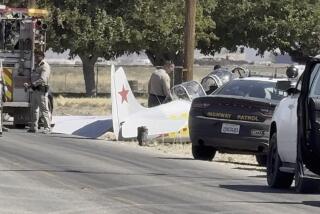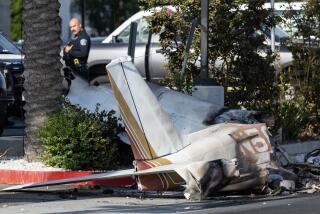Four Survive S. Dakota Crash of B-1B Bomber
RAPID CITY, S.D. — A B-1B bomber crashed and burned on a runway at Ellsworth Air Force Base in the second accident involving one of the long-range strategic jets in nine days, officials said today. The crew of four parachuted to safety.
A police officer said the $280-million plane, which crashed in a landing attempt at about 10:40 p.m. Thursday, may have come in too low and hit a utility pole. A witness said an engine was on fire before the crash.
Ellsworth spokesman Maj. Joseph B. Saxon said at the base on Rapid City’s eastern edge that the cause of the crash was not known. Saxon said the plane was carrying no weapons.The plane was on a routine training flight, the Air Force said.
“It is possible that it came in too low and hit a power pole,” said police Lt. Fred Brown. Local officials said the plane knocked down at least one utility pole.
A witness, Dale Landreth, told radio station KOTA today, “The engine was on fire before it hit the ground.”
Maj. Temple Black in Washington said a board of officers will be convened to investigate Thursday night’s crash. He speculated that weather might have been a factor. The Rapid City Journal reported fog and visibility of a half-mile at the time of the crash.
Did Not Notice Fog
Todd Heinle, a police officer in nearby Box Elder, said that it was cloudy at the time of the crash and that he did not notice any fog. He said he was a half-mile to a mile away and heard the plane make a “weird noise.”
“It almost sounded like the plane was trying to increase in power,” he said. He said he and a fellow officer saw the wings tilt one way and then the other, then the lights in the plane went out. “It was just a split second after the lights went out, there was an explosion and the flames started to come up.”
The crash came two days after officials reported that the Air Force had inspected and cleared more than two-thirds of the 98 B-1B bombers, which were grounded following the crash Nov. 8 that destroyed one of the planes in Texas.
The Thursday crash was the fourth in the four years since the United States began flying B-1 aircraft, the nation’s first new long-range bomber in more than 25 years.
The B-1 originally was killed in 1977 by President Jimmy Carter, but President Reagan reversed that decision four years later and approved the purchase of 100 B-1s for a total of $27.3 billion. Rockwell International has built all 100.
The long-range bomber is designed to fly at high speed and low altitude and deliver nuclear weapons.
More to Read
Sign up for Essential California
The most important California stories and recommendations in your inbox every morning.
You may occasionally receive promotional content from the Los Angeles Times.










